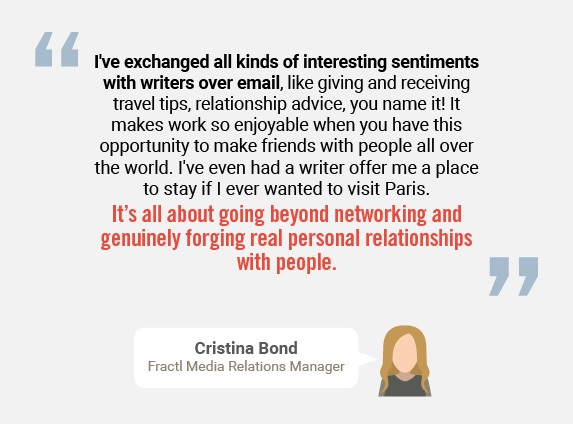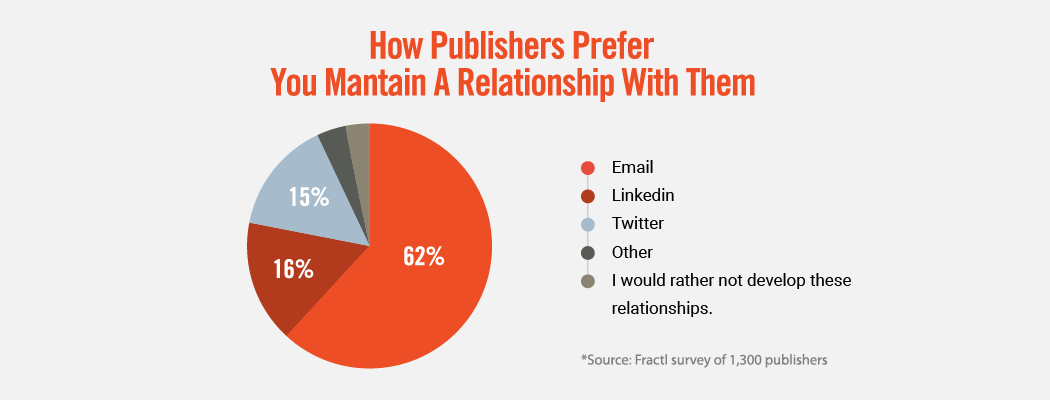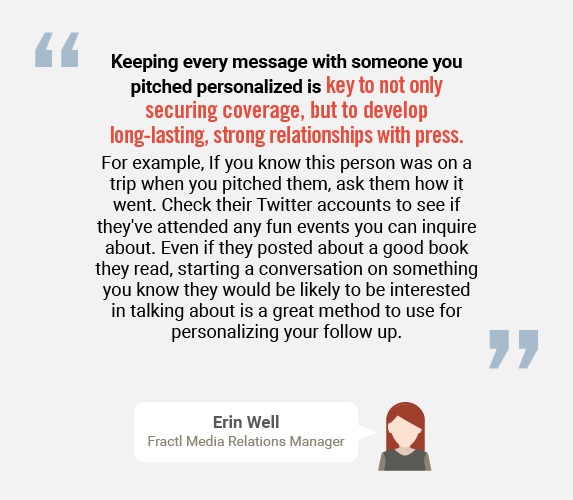This content is featured in “The Tell-All Guide to Digital PR.” Click here to download the full e-book for tips on the entire promotions process.
If you’re here because you want to form a romantic relationship with a writer, you’re in the wrong place.
But if you’re interested in connecting with writers and editors in a personal way, forming a strong business relationship and – in some cases – an actual friendship, read on.
When a marketing agency or internal content marketing team works with publishers, it’s mutually beneficial. The writer gets high-quality content to feature on his or her site, and the marketing team earns the exposure or links that go along with providing great content.
Keep this dynamic in mind, and remember:
Appeal to these people on a personal level throughout the outreach process, and you’ll be amazed at how far your efforts will go.
Here’s how to do it.
The Initial Pitch
Everything starts here. Writers will be able to easily recognize if you put in little effort crafting your pitch to them – if you send them a templated message, your email will be deleted and mentally thrown into the “non-human communication” pile.
Before you even start drafting the email, consider who you’re reaching out to. Hopefully, you’ve already done thorough research to craft the perfect pitch list. Use the information you’ve gathered to write an engaging pitch.
Personalize the Email
The best way to connect with someone is to personalize the email you’re sending. When you do this, you’re sending a signal that the recipient is worth your time and that their thoughts are important to you.
To discover the details about a writer that will help you craft a strong pitch intro, try the following:
- See if they have a bio page on their publication’s website (or check out their Twitter bio or personal website). If they do, check to see if you have anything in common you can open with.
- Read what they’ve written in the past, and if applicable, start your email with thought-provoking feedback about one of their articles or blog posts (especially if it relates to what you’re trying to pitch)!
These approaches can initiate real conversations; hopefully, you’ll connect over similar interests that will develop meaningful dialogues.
Remember: People would much rather like those they work with!
Explain How the Content Benefits Them
Again, you’re talking to a person, so the first thing you need to do is respect their time. Don’t fluff up the email at all – keep things straightforward. Only include the information that matters most.
What kind of information is that?
To form solid connections with writers, show you’ve researched their audiences and explain how the writer and their readers will benefit from your content. Writers will respect that you’re not just out to get a link but honestly want to establish a mutual benefit.
Here’s what you must include in the body of your initial pitch email:
Some writers read hundreds of pitches per week – make yours short, clear, and personalized.
Follow-Up Emails
If the writer ends up being interested in your content (because of your amazing pitch), and he or she publishes it, that’s a great win for both of you.
Because it’s a mutual win, many writers will want to maintain their relationship with you. Now that they’ve published your content once, they know they can trust the kind of material you send over and that you honestly value what their readers want to read.
How can you help maintain that relationship?
In our exclusive survey of publishers, we discovered there was a clear preference for email when maintaining communication with writers and editors, so this is always a safe bet.
When you decide to reach out via email to your contact, there’s one key thing to keep in mind.
Don’t always send them content related to your work or your client’s work.
Sending too many direct pitches too quickly will change the tone of the conversation and might lead the writers to feel you’re now just trying to use this open communication to get as much published as possible, without the same careful consideration you took the first time around.
Keep up the personal discourse. Find out more about the person behind the writer. You can develop this conversation by:
- Providing a bit of information about yourself. What did you do last weekend? What exciting plans do you have coming up? Opening up about your life could lead to conversations that help you find things in common.
- Talking about something the writer/editor recently published. Take a topic they’re obviously interested in and comment on it. This is a discussion they’re much more likely to be engaged by.
And if the writer does happen to be very active on and prefer social, try the following:
Taking the time to invest in your outreach connections will not only be a win-win for all involved – but it will also lead to a more pleasant work experience and potentially a genuine friendship.












